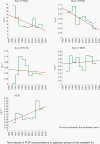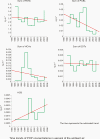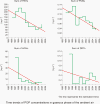|
|
AIR POLLUTION IN THE CZECH REPUBLIC IN 2006 Czech Hydrometeorological Institute - Air Quality Protection Division |
|
|
|
|
II.6 Long-term trends of POP concentrations in the ambient air and deposition at the background station Košetice Introduction POP monitoring POP monitoring within the programmes of the Košetice Observatory is a part of long-term cooperation between CHMI, RECETOX, Faculty of Sciences of the Masaryk University in Brno and TOCOEN, s.r.o. This monitoring is a significant part of two long-term projects of the RECETOX Centre, and namely of TOCOEN Project (Toxic Organic Compounds in the Environment, since 1988) and INCHEMIOL Project (Interactions among the chemicals, environment and biological systems and their consequences on the global, regional and local scales, since 2005). The monitoring design is based on the EMEP POP monitoring strategy. Based on the EMEP recommendations long-term monitoring is carried out in all the mentioned matrices for polyaromatic hydrocarbons (PAH, 16 US EPA), polychlorinated biphenyls (PCB: IUPAC congeners 28, 52, 101, 118, 153, 138, 180), hexachlorbenzene (HCB) and pentachlorbenzene (PeCBz), α- and γ-hexachlorcyklohexanes (HCHs), p,p’-DDT, p,p’-DDD and p,p’-DDE. POP monitoring at the Košetice Observatory has been carried out for 19 years, which represents a very unique series of results. As for POP monitoring in the ambient air the sampling frequency in 1988–1993 was once in three months, at the end of this period once in a month. Since 1994 the samplers have been taken once a week by a large-volume sampler (every Wednesday, 08.00 – Thursday, 08.00), which represents 52–53 samples per year. As concerns wet deposition, each precipitation event is monitored. The samples are analyzed to detect the content of polycyclic aromatic hydrocarbons (PAH), polychlorinated biphenyls (PCB) and organochlorine pesticides (OCP). The regional POP monitoring at the Košetice Observatory serves as the basis for the assessment of the level of environmental contamination by these pollutants and data on POP monitoring are used within the EMEP activities for the validation of global and regional models for transport and history of these pollutants. POP determination is carried out from ambient air samples (weekly sampling), wet deposition (each precipitation event) and in surface water, sediments, soils, moss and needles (once a year in 8 other localities within the premises of the observatory). This unique programme is currently implemented in such extent only at the Košetice Observatory within EMEP programmes aimed at air quality monitoring, deposition and the so called integrated monitoring. Results Tab. II.6.1 sums up the detected concentrations of the monitored POP for the period 1996–2005 (average, median, minimum, maximum of the measured concentrations of all groups of POP). The maximum PAH concentrations in the ambient air reach hundreds of ng.m-3 for the sum of 16 PAH in gaseous and aerosol phases (median 8 ng m-3 and 2 ng m-3). On the contrary, maximums of the detected concentrations of the monitored chlorinated substances reach hundreds of pg.m-3. Approximately one half is bound to solid particles, the majority of chlorinated substances was present in the gaseous phase. As concerns individual monitored substances, the highest concentrations in the gaseous phase were detected in case of fenantrene (median = 4 ng m-3, maximum = 31 ng m-3) and fluorene (median = 2 ng m-3, maximum = 23 ng m-3); in aerosols the dominating substances included fluorantene (median = 0.5 ng m-3, maximum = 19 ng m-3), pyrene (median = 0.5 ng m-3, maximum = 13 ng m-3) and fenantrene (median = 0.3 ng m-3, maximum = 15 ng m-3). As concerns PCB, no predominance of any of the monitored congeners was detected in the ambient air. In case of the monitored isomers of hexachlorcyclohexane (HCH), the measured concentrations of γ- HCH (lindane) were approximately twice higher than in α-HCH and as concerns DDT and its metabolites, the amount of p,p’-DDE was approximately twice higher than the detected amount of p,p’-DDT. The occurrence of PCB corresponds with the usual levels of the European background. In DDT the predominance of degradation metabolites (DDE, DDD) is still noticeable, i.e. there are old loads rather than significant long-range transport. Typical seasonal variations with the maximums in the winter period, i.e. in the winter heating season, are shown in Fig. II.6.2. The highest levels are detected in January and February, when they can be even by three orders higher than the values detected in July and August, when the emitted amounts are markedly lower and, moreover, there is photodecomposition due to solar radiation. January monthly averages range between 22 and 86 ng.m-3, while in July only between 1 and 4 ng.m-3. The PCB and OCP concentrations show very different profiles (Figs. II.6.3–II.6.6). The majority of these substances were banned in Europe a long time ago and their maximums are not connected with their production or seasonal applications. They are present in the atmosphere as a result of volatilization from old deposits (soils, sediments, waste) or due to long-range transport from the regions where they are still produced and applied. In accordance with this hypothesis their seasonal maximums occur in warmer periods of the year, when, due to higher temperatures, they volatilize mostly from contaminated soils and waste dumps in the Czech Republic. Seasonal trends of chlorinated substances are not as apparent as in the case of PAH (Figs. II.6.2–II.6.6). POP concentrations detected in precipitation water reflect the concentrations detected in the ambient air. The most frequented PAH were: fenantrene, fluorene and pyrene; γ-HCH was detected in all samples in the highest levels for all monitored PCB and OCP. The average monitored concentration of PAH (EPA 16) reached 120 ng.l-1, the average concentrations of chlorine substances were lower: 0.5 ng.l-1 for the sum of 7 PCB, 5 ng.l-1 for the sum of HCH, 0.2 ng.l-1 for the sum of DDT and 0.05 ng.l-1 for HCB. Seasonal variations of the monitored POP in precipitation are similar to seasonal variations in the ambient air, especially in the case of PAH (Fig. II.6.7). The summer minimum reached only 2 ng.l-1, the winter maximum reached 6.310 ng.l-1. For all the monitored groups of POP (PAH, PCB, DDT, HCH and HCB) in the ambient air (gaseous phase and aerosols) and in precipitation water medians of annual concentrations were calculated and these values for the assessed period 1996–2005 fro each group were compared with the long-term trends (Fig. II.6.8–II.6.10). These analyses cover the changes of time trends of the concentrations of the monitored pollutants. The interesting development is shown by the concentrations of the sum of 16 PAH in gaseous phase in the ambient air (Fig.II.6.8), when decrease was recorded in the years 1996–2000 followed by the increase in 2001–2002 caused probably by local economic situation in the Czech Republic ensuing from the growth of prices of natural gas and from the return to coal and wood combustion in local furnaces. Similar trend was recorded also in PAH concentrations in atmospheric particles and precipitation. Annual medians of PCB and OCP also show the decreasing trend broken by two periods of higher concentrations (Fig. II.6.8) in the years 1997–1998 and 2002–2003. As it is apparent from Fig. II.6.3, significant summer maximums of PCB concentrations were detected in the years 1997 and 1998 (maximums 390 pg.m-3 and 337 pg.m-3 for the sum of 7 PCB congeners in the years 1997 and 1998, respectively). Similar situation was detected in the case of organochlorine pesticides (Figs. II.6.4–II.6.6). This increase can be connected with the floods in the years 1997 and 2002. Vast areas of central and southern Moravia (east of Košetice) were flooded in 1997, including industrial and farming enterprises. Similarly, the area of central Bohemia (west of Košetice incl. Prague) was flooded in 2002. A number of chemical enterprises, storage houses and waste dumps with potential content of various chemical substances, incl. POP were flooded by water. The floods were followed by extremely hot summer months which, after drying the inundated surface waters, resulted in evaporation of redistributed chemical substances from old loads and flooded industrial enterprises and, consequently, in the increase of POP levels in the ambient air at the regional background observatory in Košetice. Floods, apart from a number of tragic impacts, may also make a negative contribution to the redistribution of chemical loads in the environment. The graphs show the apparent decreasing trend of concentrations in the regional background of the monitored pollutants. Summary statistical evaluation of the concentrations of all monitored POP in the ambient air, gaseous phase and aerosol, (medians, 25–75 %, non-outlier range, outliers and extremes) are presented in Figs. II.6.11–II.6.15. In the monitored period, only hexachlorbenzene shows statistically significant trend of increasing concentrations in the ambient air caused by high levels in the post-flood years. Tab. II.6.1 Overview of POP concentrations, Košetice Observatory, 1996–2005 Fig. II.6.1 POP
monitoring, EMEP network, 2000
Fig. II.6.2 ΣPAH in the ambient air, Košetice Observatory, 1996–2005
Fig. II.6.3 ΣPCB in the ambient air, Košetice Observatory, 1996–2005
Fig. II.6.4 ΣHCH in the ambient air, Košetice Observatory, 1996–2005
Fig. II.6.5 ΣDDT in the ambient air, Košetice Observatory, 1996–2005
Fig. II.6.6 HCB and PeCB in the ambient air, Košetice Observatory, 1996–2005
Fig. II.6.7 ΣPAH in precipitation water, Košetice Observatory, 1996–2005
Fig. II.6.8 Time trends of POP concentrations in gaseous phase of the ambient
air. The line represents the estimated trend
Fig. II.6.9 Time trends of POP concentrations in aerosol of the ambient air. The
line represents the estimated trend
Fig. II.6.10 Time trends of POP concentrations in wet deposition. The line
represents the estimated trend
Fig. II.6.11 ΣPAH concentrations in the ambient air, gaseous phase and aerosol,
(medians, 25–75 %, non-outlier range, outliers and extremes)
Fig. II.6.12 ΣPCB concentrations in the ambient air, gaseous phase and aerosol,
(medians, 25–75 %, non-outlier range, outliers and extremes)
Fig. II.6.13 ΣHCH concentrations in the ambient air, gaseous phase and aerosol,
(medians, 25–75 %, non-outlier range, outliers and extremes)
Fig. II.6.14 ΣDDT concentrations in the ambient air, gaseous phase and aerosol,
(medians, 25–75 %, non-outlier range, outliers and extremes)
Fig. II.6.15 ΣHCB concentrations in the ambient air, gaseous phase and aerosol,
(medians, 25–75 %, non-outlier range, outliers and extremes)
|














